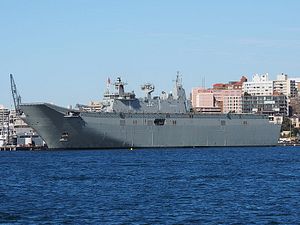The first-of-class amphibious assault ship HMAS Canberra, the largest ship to be ever operated by the Royal Australian Navy (RAN), will participate in this year’s Rim of the Pacific (“RIMPAC”) international naval exercise to test the ship’s interoperability with air and sea platforms of partner navies, IHS Jane’s Navy International reports.
This will be the first major international naval exercise for the lead vessel of the Canberra-class. (The second 27,800-ton Canberra-class landing helicopter dock ship, HMAS Adelaide, was commissioned in December 2015.) The HMAS Canberra can accommodate up to 1,046 troops (on top of the ship’s company) along with their equipment, roughly 110 vehicles and between eight to 18 helicopters that can airlift 220 soldiers at a time. The HMAS Canberra can also carry up to a million liters of aviation fuel.
The commanding officer of the HMAS Canberra, Captain Christopher Smith, told IHS Jane’s Navy International that the ship’s primary mission during the exercise will be to test its interoperability with allied navies. “The focus for Canberra ‘s visit over there at RIMPAC is to get interoperability with some of our allied navies. (…) We will [also] be embarking a range of nations on board from a land force perspective for the actual exercise.”
According to Smith, the Canberra will accommodate the U.S Navy’s MV-22 Osprey tiltrotor aircraft as well as the CH-53 Sea Stallion helicopter. The MV-22 Osprey is a hybrid between a conventional helicopter and turboprop plane with both a vertical takeoff and landing (VTOL) and a short takeoff and landing (STOL) capability. The CH-53 is the largest military helicopter in the U.S. military, capable of carrying a 26,000-pound armored vehicle or 16 tons of cargo.
RIMPAC, the world’s largest international maritime warfare exercise, is held biennially in June and July of even numbered years in waters around the Hawaiian Islands. The naval drill is administered by the U.S. Navy’s Pacific Fleet, headquartered at Pearl Harbor, Hawaii, and other U.S. government entities, including the U.S. Marine Corps.
A 2015 study by the Australian Strategic Policy Institute (ASPI) posited that Australia still lacks expertise to deploy a cutting-edge amphibious warfare capability. “Australia’s position in the world makes the effort a strategic imperative, but the ADF still has a long way to go and many critical decisions ahead if it’s to develop an amphibious warfare capability that’s ready for future challenges,” the paper reads (See: “Australia Lacks Expertise to Deploy World-Class Amphibious Warfare Capability”).
The Australian Defense Force (ADF) “lacks the tradition, culture, and organizational expertise needed to maintain and employ a world-class amphibious warfare capability,” according to the paper. The report singles out the Australian Army especially as lacking resources and know-how.

































